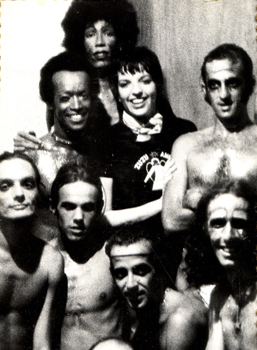
Liza Minnelli surrounded by members of Dzi Croquettes in 1974
Directed by Tatiana Issa & Raphael Alvarez
Produced by Tria Productions & Canal Brasil
English & Portuguese with English subtitles
Brazil. 110 min. Not rated
“Gays don’t die. They turn into glitter.” These words of wisdom were told to co-director Tatiana Issa when she was a girl by her father, a technician for the Brazilian gender-bending cabaret act Dzi Croquettes, the subject of her tribute. But will American viewers with no familiarity of this group find much to hold their interest during this fond remembrance? Yes, to a point. The documentary has an ace tucked in its spangled G-string: Liza Minnelli, the voice of authority among the chorus of exuberant interviews. If anyone knows about the art of giving the old razzle dazzle, it’s this daughter of show business royalty. (Just watch her Liza with a Z one-woman TV special, or, better yet, rewatch Cabaret.) When the Brazilian troupe played to empty houses during its debut Paris run, Minnelli saved the day, touting the show as the best in town and persuading critics to see it. Soon, Mick Jagger, Catherine Deneuve, and Omar Sharif joined the fan club.
Named for the combination of the thick Portuguese pronunciation of “the” and the fried potato dish, the group of 13 gay men formed during Brazil’s draconian dictatorship of the 1960s and ’70s led by former med student-turned-actor Wagner Ribeiro. All lived together like one family, including an impish American, Broadway dancer Lennie Dale, who found a foothold in Brazil in the late ’60s as a mentor to the superstar singer Elia Regina. (For most Americans, the most famous name on camera, besides Minnelli, is musician Gilbert Gil.) Left unsaid is how the group fit into the nascent gay rights movement or visibility in their home country, or how they were possibly influenced by such American troupes like the Cockettes, based in San Francisco. Dale was from New York, after all. As a trade-off, the film delves into the backstage drama of the daisy chain of personal relationships and then the inevitable Behind the Music-like meltdown.
For those who never saw their stage shows, what are we to make of them? From the snippets of clips, the banter and production numbers seem like a cross between the exuberant choreography of an old-school variety show (think Dean Martin’s Golddigger dancers, if they were incredibly fit men wearing barely-there, bulging G-strings) and any of the versions of La Cage aux Folles. There was no chance of mistaking them for women, yet with visor-like false eyelashes and clown-like make-up, they weren’t performing in drag either. However, based on the grainy home videos of their act, there’s not enough seen to live up to the talking-heads’ enthusiasm, with the exception of two extended clips, of about a minute each, which capture the fluid and sinuous dance numbers. Based on the testimony of Minnelli and the surviving members, you had to be there.






Leave A Comment